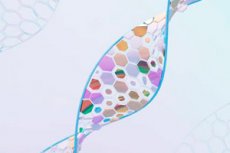New publications
Systematic analysis of MUTYH gene variations helps to more accurately assess colon cancer risk
Last reviewed: 03.08.2025

All iLive content is medically reviewed or fact checked to ensure as much factual accuracy as possible.
We have strict sourcing guidelines and only link to reputable media sites, academic research institutions and, whenever possible, medically peer reviewed studies. Note that the numbers in parentheses ([1], [2], etc.) are clickable links to these studies.
If you feel that any of our content is inaccurate, out-of-date, or otherwise questionable, please select it and press Ctrl + Enter.

Genes are passed down from parents and determine traits such as eye color and height, as well as the risk of certain diseases.
Although cancer-associated genes such as BRCA1 and TP53 are relatively familiar, most variants fall into a general category known as variants of uncertain clinical significance.
Currently, a person with a family history has only a limited chance of using their genetic screening data to determine their risk for most diseases.
A recent study from the lab of Jacob Kitzman at the University of Michigan Medical School reveals new clues about the risk associated with variants in a colon cancer-linked gene called MUTYH, whose normal function is to repair DNA. The paper is published in The American Journal of Human Genetics.
Variants in MUTYH can cause abnormal growths to form in the body, especially in the colon, increasing the risk of deadly colon cancer.
These variants are also quite common: up to one in every 50 people in the United States carries risk variants of this gene.
"It's really important to identify the subset of people who have an inherited familial risk factor because for them, prevention can be life-saving," said Kitzman, an associate professor of human genetics.
Not all variants, or mutations, are the same.
Nonsense variants are those that "break" the gene, while synonymous variants have no effect and are benign.
So-called missense variants occur when a change in the DNA sequence results in a different protein being made.
To study these variants, rather than creating cell or animal models with one variant at a time and studying any functional changes, the team used a mixed model, creating all possible MUTYH variants, forming a library of 10,941 variants.
They then used a DNA repair system reporter to systematically measure the function of each variant.
"Basically, we inserted an oxidative damage sensor into the cells that lights up green if the repair is going well and doesn't light up green if the repair function is impaired," Kitzman explained.
They then divided the cells into two categories: functional and non-functional.
Using this method, they were able to clearly separate nonsense variants from synonymous (silent) variants.
They also characterized a number of missense variants that fell in the middle range with effects lying on a continuum of functionality.
They further confirmed the clinical significance of these MUTYH mutations by comparing them with the National Center for Biotechnology Information (NCBI) ClinVar database, which contains variants discovered through genetic testing and reviewed by clinicians.
"It turned out that some of the mutations in MUTYH are common in human populations, and their pathogenicity was perfectly captured by our test," Kitzman said.
For example, one variant in the intermediate range corresponds to a clinical variant known for its later onset and milder form of polyp development.
In addition to providing more evidence about what variants of uncertain meaning actually mean, Kitzman notes that this kind of functional analysis could help people make more informed decisions about disease prevention based on their genetic information.
"Genetic testing is becoming more and more common, and while we can read letters in a book, we don't know how to turn them into words and sentences and how to understand what those sentences mean," Kitzman said.
“We need to continue to fund basic science research to realise real benefits, such as the ability to interpret cancer risk from genetic testing results, which could lead to life-saving prevention.”
